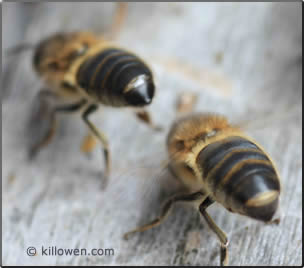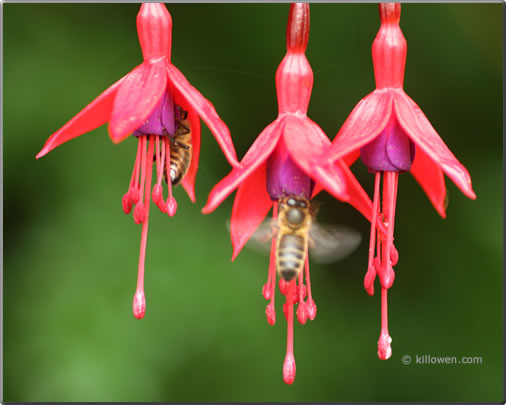June, July and August
Honey extraction
Springtime honey (if any) is taken off at the beginning of June. This honey is expected to set rapidly owing to the presence of dandelion nectar. Experience has shown that this honey could set before it can be extracted. In the past this honey has been fed back to the bees as a winter store.
Springtime honey (if any) is taken off at the beginning of June. This honey is expected to set rapidly owing to the presence of dandelion nectar. Experience has shown that this honey could set before it can be extracted. In the past this honey has been fed back to the bees as a winter store.
Queen rearing
This is normally started in the second week in May, however, if the weather is unfavourable then it is best to delay until the weather improves.
If the May weather is favourable then it will be the middle of July at the earliest before the new queens can be assessed and ready for sale.
This is normally started in the second week in May, however, if the weather is unfavourable then it is best to delay until the weather improves.
If the May weather is favourable then it will be the middle of July at the earliest before the new queens can be assessed and ready for sale.
This is perhaps the hardest part of beekeeping. Most books would suggest that monitoring starts in earnest at the beginning of May with an examination of each colony for queen cells; but middle April is sometime not too early. How to do this !
In spite of one's best intentions swarm control is not always successful. I look for queen cells every 7 days. But this is not always possible because of other commitments or poor weather; so inevitably some queen cells may be formed but are not discovered until it is too late.
I have found it pays to make a quick inspection of the apiary every morning, looking for a swarm on the fruit trees and hedge we have. Sometimes a swarm has spent the night in such a situation and is ready to fly the following morning.
It is a case of doing ones best and taking immediate action if queen cells are found. It goes without saying that a well thought out strategy is to be followed before an inspection is undertaken; with all necessary extra equipment at hand ready for immediate use. I have dealt with this aspect under 'swarming' and 'the swarming impulse' in the menu above.
In spite of one's best intentions swarm control is not always successful. I look for queen cells every 7 days. But this is not always possible because of other commitments or poor weather; so inevitably some queen cells may be formed but are not discovered until it is too late.
I have found it pays to make a quick inspection of the apiary every morning, looking for a swarm on the fruit trees and hedge we have. Sometimes a swarm has spent the night in such a situation and is ready to fly the following morning.
It is a case of doing ones best and taking immediate action if queen cells are found. It goes without saying that a well thought out strategy is to be followed before an inspection is undertaken; with all necessary extra equipment at hand ready for immediate use. I have dealt with this aspect under 'swarming' and 'the swarming impulse' in the menu above.
Seasons: Summer
Monitoring for varroa
Each colony is monitored for varroa at the start of each month. A varroa screen is placed underneath each OMF for 4 days to gets an idea of the natural mite drop.
Each colony is monitored for varroa at the start of each month. A varroa screen is placed underneath each OMF for 4 days to gets an idea of the natural mite drop.
 The photo above shows two bees from a swarm on the alighting board with their Nasanov glands open inviting the bees to occupy their new home.
The photo above shows two bees from a swarm on the alighting board with their Nasanov glands open inviting the bees to occupy their new home. Wasps
The summer of 2023 was spectacular not only for the bees but also in the proliferation of wasps in the apiary. The solution was to close up the entrances to the main colonies to about 4" and let the guard bees fight off any wasp trying to gain access to the hive.
However, nucs were particularly vulnerable to wasp attack and a number were lost. A nuc is mainly composed of young bees whose job is to look after the brood and the new queen. Dealing with a persistent wasp attack is somewhat beyond their ability. I do not know if there is a solution. Wasp traps whilst catching a few cannot deal with the quantity which attack when news gets out to the wasp colony that there is an easy supply of honey in a nuc.
Perhaps it is prudent to start with bee breeding as early in the season as possible before the wasps have become established.
The summer of 2023 was spectacular not only for the bees but also in the proliferation of wasps in the apiary. The solution was to close up the entrances to the main colonies to about 4" and let the guard bees fight off any wasp trying to gain access to the hive.
However, nucs were particularly vulnerable to wasp attack and a number were lost. A nuc is mainly composed of young bees whose job is to look after the brood and the new queen. Dealing with a persistent wasp attack is somewhat beyond their ability. I do not know if there is a solution. Wasp traps whilst catching a few cannot deal with the quantity which attack when news gets out to the wasp colony that there is an easy supply of honey in a nuc.
Perhaps it is prudent to start with bee breeding as early in the season as possible before the wasps have become established.
 Fuchsia is an important nectar source in Ireland from July onwards.
Fuchsia is an important nectar source in Ireland from July onwards.Swarm control
